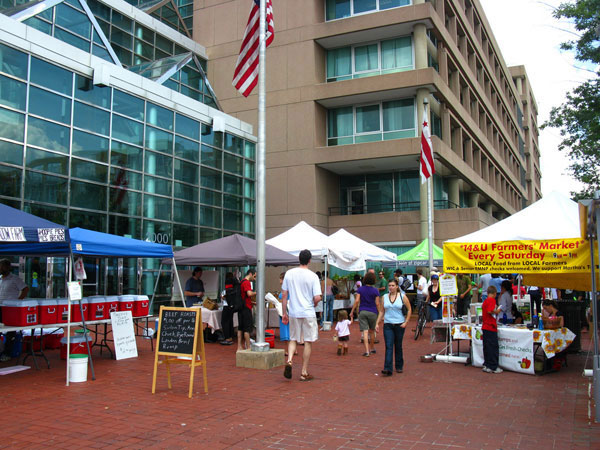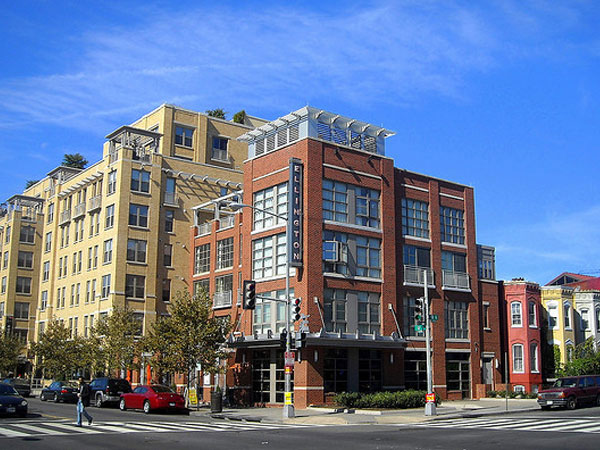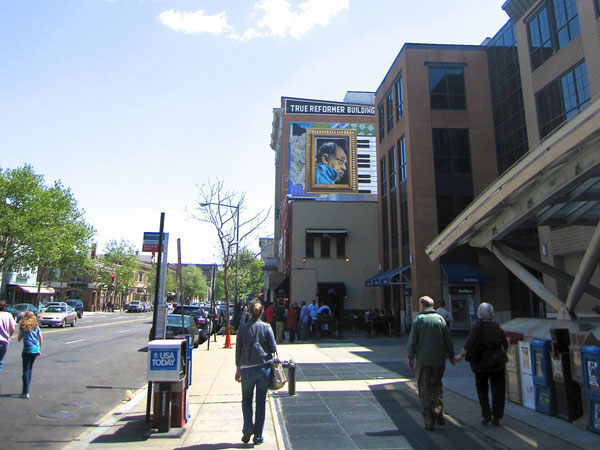U Street N.W.: Washington, D.C.

Summary
In 2009 when president-elect Barack Obama ordered a chili half-smoke at the famous Ben's Chili Bowl along U Street N.W., crowds flocked to the legendary eatery and the street it has anchored since 1958. U Street has gone through difficult times, particularly the lingering aftermath of devastating riots following the 1968 assassination of Dr. Martin Luther King, Jr. Today the street is pulsing again with the music, businesses and life that, in the early 1900s, distinguished it as the main street of Washington's "city within a city."
Designated Area
Seven blocks of U Street N.W. between 9th and 16th Streets N.W.

The Reeves Center (1986) was the cornerstone of redevelopment of the U Street corridor; the city invested $50 million and houses some city agencies there. The building set-back created an urban plaza, the site of a weekly farmers market and other events. Photo Flickr user thisisbossi, Creative Commons license.
Planning Excellence
In then-segregated Washington, U Street was an epicenter of African American businesses, entertainment, and civic and religious life. The street earned the nickname "Black Broadway" for the number of theaters and jazz clubs that attracted the country's top black musicians, including Duke Ellington, Ella Fitzgerald, Louis Armstrong, Nat "King" Cole, Pearl Bailey, and "Jelly Roll" Morton.
The street also was the site of buildings designed by several prominent, 20th century African American architects, including John Lankford, considered the "dean of black architecture."
Following World War II and the invalidation of the city's racially restrictive real estate covenants in 1948, the character of the street as the hub of the African American cultural and entertainment scene in Washington, D.C., changed. A long period of decline began, punctuated and accelerated by the 1968 shooting of Dr. King and subsequent rioting along U Street N.W., 14th Street N.W., and the surrounding area.
Recovery from the damage and subsequent disinvestment because of the riots did not take hold until the mid-1980s and early 1990s, with construction of the Reeves city government building, the U Street–Cardoza Metrorail station, and new housing as well as the opening of new businesses.
Today the street's vibrancy has returned. New and restored venues host a variety of musical styles. Restaurants and bars teem with crowds of all ages and backgrounds, and new and long-time residents mix at the farmers market or among striking historic buildings. Observes Jane Freundel Levey, director of heritage programs at Cultural Tourism DC: "14th and U ... [are] absolutely right now the epitome of the new multicultural America."

New and restored buildings add to the street's revitalized vibrancy. Photo Flickr user NCinDC, under a Creative Commons Attribution-No Derivative Works license.
Defining Characteristics, Features
Prominent African American architecture
- True Reformer Building, 1200 U St. N.W., headquarters for African American fraternal and benevolent society, designed in Renaissance Revival style by John Lankford (1902)
- Minnehaha Nickelodeon Theater (1909), 1213 U St. N.W., now the home of Ben's Chili Bowl; Renaissance Revival style designed by P.A. Hurlehaus
- Industrial Savings Bank (1917), 11th and U Streets N.W., designed by Isaiah T. Hatton; demonstrates early 20th century style blending with surrounding 19th century residential architecture
- Prince Hall Masonic Temple (1922), 1000 U St. N.W., designed in the neoclassical style by Albert Cassell, prominent African American architect of many civic, church, and Howard University buildings in D.C.
History, Culture
- Lincoln Theater (1922), 1215 U St. N.W., served African American community during segregation; closed after 1968 race riots but reopened in 1994 after being restored with $10 million in public and private funds
- Jazz club Bohemian Caverns, 11th and U Streets N.W., opened as Club Caverns in 1926; became Crystal Caverns and closed in 1968; reopened 1999
- U Street Neighborhood Association led historic district designation effort; hosts Annual Holiday Party, Silent Auction, and Community Clean-Up Day
- Living City Block DC installed community garden at Paul Laurence Dunbar Apartments in July 2011; raised beds make garden accessible to all residents
Revitalization
- Reeves Center, 14th and U Streets N.W., houses city agencies; built in 1986, is cornerstone of redevelopment with city investment of $50 million; building set back from street to create urban plaza, site of current Saturday farmers market
- Street becomes more accessible with opening of Metrorail station for Green and Yellow Lines (1991); many bus lines also serve street
- New, popular bike-sharing program, Capital Bikeshare, has stations at 10th and U Streets N.W. and 16th and U Streets N.W.
- 1998 HUD grants helped fund "Remembering U Street" Historic Signage marking 15 historic sites and U Street Commercial Facade Improvement to more than 150 dilapidated properties on U and 14th Streets N.W.
- New housing development bringing new residents and revenue; mostly high-end apartments constructed or renovated from older buildings
- All 48 units of Portner Place, 1449 U St. N.W., are affordable, Section 8 housing
- Tenants partner with developer to purchase the seniors-only housing complex, Paul Laurence Dunbar Apartments (15th and U Streets N.W.); Section 8 contract extended for 20 years to keep apartments affordable

The Renaissance Revival style True Reformer Building (1902) pays homage to U Street's entertainment history with its Duke Ellington mural. In the foreground (right) is one of two entrances to the Metrorail station serving the street. Photo Flickr user tedeytan, under a Creative Commons license.


